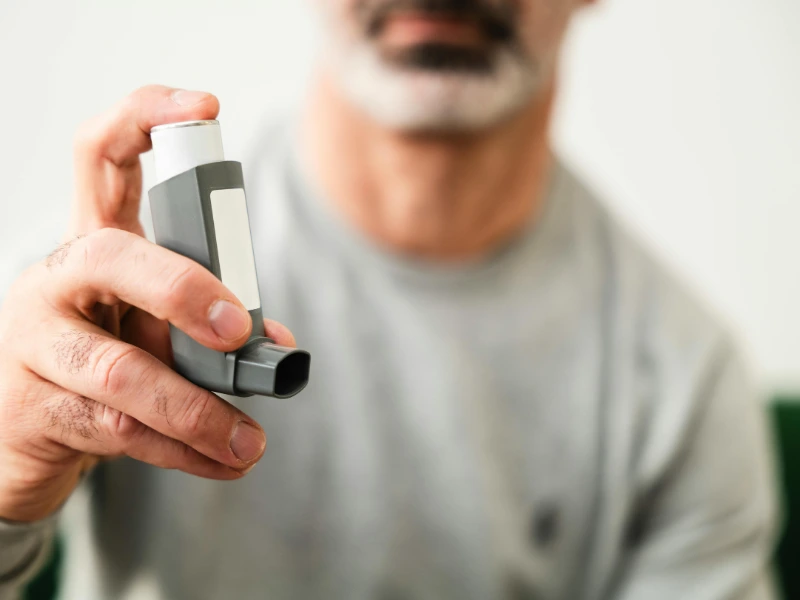Having always been passionate about staying active, discovering I had exercise-induced asthma was a major challenge. At first, I couldn’t understand why my chest tightened and I experienced breathing difficulties during workouts, even in an air-conditioned gym. After moving to Dubai, the intense heat and high humidity worsened my symptoms, making physical activity even harder. I soon realized that air quality, weather, and even the time of day greatly affect my breathing. Accepting my condition was a turning point, and I learned that with adjustments and by listening to my body, I could still pursue my fitness goals.

Why We Are Prone to Exercise Induced Asthma?
While working out in Dubai, I noticed many gym partners struggling with shortness of breath. At first, I blamed the heat, but after experiencing exercise-induced asthma myself, I realized it’s far more common here than I thought. The primary factor is Dubai’s unique climate and air quality.
Dubai’s extreme heat, high humidity, dust storms, and rising pollution create air irritants that often trigger exercise-induced asthma. Construction dust makes it worse, especially in summer. Greater public awareness, regular pulmonary check-ups, and using environmental monitoring apps can help reduce risks for residents. Exercise-induced asthma is manageable, but only if we understand the specific triggers of Dubai’s environment.
Why Dubai’s Humid Weather Makes it Worse?
Moving to Dubai, one of the world’s fastest-paced cities, was the best decision I could have made. However, as someone with exercise-induced asthma, I’ve noticed a significant difference in how my body reacts during workouts, especially outdoors. While I mentally prepared for the desert heat, I didn’t anticipate the intense humidity. The summer months bring a level of humidity that can lead to breathing difficulties, chest tightness, and even early fatigue during exercise.
Humid air can constrict the airways and carry irritants like dust, pollutants, and mold that worsen asthma. To cope, use a portable air quality monitor, avoid peak humidity hours (10 AM–6 PM), and keep your inhaler handy. Dubai’s climate may be harsh, but with the right strategies, exercise-induced asthma doesn’t have to take control.

The Impact of High Temperatures on Exercise Induced Asthma
Exercising in Dubai comes with unique challenges, particularly for someone like me dealing with exercise-induced asthma (EIA). The extreme heat, often soaring above 40°C, makes breathing hot air—whether dry or humid—trigger asthma symptoms by tightening the airways and causing breathing difficulties. For those of us with asthma, engaging in physical activity in such conditions isn’t just uncomfortable; it’s dangerous.
As the temperature rises, I’ve noticed the air becomes thinner, reducing oxygen levels and making it harder to breathe during exercise. In Dubai, it’s not just about fitness—it’s about safety. To manage exercise-induced asthma effectively, know your limits, stay hydrated, and work out at the right times. By understanding how heat affects asthma and adapting to Dubai’s climate, you can stay active while reducing risks.
Exercise Induced Asthma and the Impact of Sweat
Exercise is a vital part of my daily routine, but with exercise-induced asthma, even simple workouts can feel like a battle. When we sweat, the evaporation process cools our bodies, but in Dubai, the high humidity prevents sweat from evaporating quickly. This means our bodies stay hotter for longer, increasing the risk of asthma flare-ups and breathing difficulties.
Understanding this connection is crucial for managing exercise-induced asthma, especially during outdoor workouts. To prevent sweat-related flare-ups, stay hydrated before, during, and after exercise to regulate body temperature. Choosing cooler indoor gyms and wearing breathable fabrics also helps manage symptoms effectively.

How Dust in Dubai’s Air Triggers Exercise Induced Asthma?
WhileI truly appreciate the unique vibrancy of Dubai and its remarkable skyline there’s one issue I can’t ignore, the dust. The dust in Dubai’s air is a constant presence, especially during the hotter months when sandstorms are common. As someone with asthma, I know firsthand how easily dust in the air can trigger my symptoms. Fine particles of dust and sand irritate my airways, leading to breathing difficulties and chest tightness.
On days when the winds are strong, the air quality can become dangerous, increasing the likelihood of an asthma attack. Even mild dust exposure over time can cause breathing difficulties, leaving me feeling breathless, with a tight chest, and sometimes struggling to find cure. This makes everyday activities, like walking or running errands, feel exhausting.
Dust storms are common in Dubai, but even minor long-term exposure can harm respiratory health. The mix of dust and urban pollution often triggers exercise-induced asthma, making awareness, better air quality, and reduced exposure essential for protection.
Shortness of Breath While Walking in Villa Communities
Dubai’s villa communities may offer greenery and peace, but they also pose challenges for those with exercise-induced asthma. Shortness of breath during walks is often triggered by dry desert air, dust storms, pollution, and plant allergens.
Seasonal pollen and allergens can make walking difficult for those with exercise-induced asthma. Staying vigilant, using inhalers, and avoiding outdoor activity during peak pollution times are key preventive measures. Understanding and addressing these triggers is vital for maintaining a healthy, active lifestyle in Dubai’s villa communities.

Running in Dubai’s Heat: Struggle with Exercise Induced Asthma
As a runner living in Dubai, managing exercise-induced asthma (EIA) during the peak summer months is a constant struggle. With temperatures above 40°C, Dubai’s heat and humidity strain the lungs and trigger airway narrowing, making outdoor runs especially tough for those with asthma. These extreme conditions make it incredibly difficult to maintain a consistent exercise routine.
Running early mornings or evenings in Dubai reduces heat, but pollution, dust, and allergens still cause breathing difficulties. What should be a refreshing jog often feels like a battle against my own body, with the constant need to monitor my breathing and keep medication on hand essential just to finish the workout.
Dubai Mallathon: A Safe, Clean Environment
Finding a safe, breathable space to exercise in Dubai can be difficult, but the Dubai Mallathon offers a unique solution. Held inside Dubai Mall, it unites fitness enthusiasts in a clean, controlled environment. This makes it ideal for people with exercise-induced asthma. According to Gulf News, the Mallathon is part of Dubai’s effort to transform malls into fitness communities. It encourages people to stay active regardless of the weather.
This event reflects Dubai’s commitment to fostering a healthy, clean atmosphere where fitness and wellness can thrive year-round. For individuals like me, who are cautious about asthma triggers in public spaces, the Mallathon is a breath of fresh air. It provides a controlled environment where we can focus on our fitness goals while prioritizing our health. The event highlights that in Dubai, fitness is more than a lifestyle—it’s a community effort that’s inclusive for those with asthma.

Finding the Right Time to Run
Timing is crucial when staying active and managing exercise-induced asthma, especially in Dubai’s hot, dry climate. Outdoor activities here can be challenging, so it’s essential to choose the right time of day for a run to reduce the risk of triggering an asthma attack.
Early mornings, soon after sunrise, offer the best conditions. The temperature is cooler, and air quality is generally better than in the afternoon, when pollution levels tend to peak. This gives your lungs a better chance to function properly. Evenings after sunset are also favorable for running in Dubai, as the weather starts to cool, and the city offers a quieter atmosphere.
In Dubai, it’s important to monitor not just temperature but also air quality, as dust and allergens—especially during sandstorms—can trigger breathing difficulties. Checking the AQI before runs is a game changer; if it’s high, I switch to indoor options like treadmill workouts. From experience, preparation is key—choosing the right time to run and carrying my inhaler helps me stay active while managing asthma.
Cycling at Al Qudra: Challenges for Exercise Induced Asthma
Cycling at Al Qudra in Dubai is a liberating experience, offering riders miles of desert terrain and a chance to connect with nature. However, for those of us with exercise-induced asthma, this stunning location comes with its own set of challenges. The biggest hurdle I’ve encountered while cycling here is the heat and dryness of the desert air. For asthma sufferers, these dry conditions can irritate the airways and make breathing more difficult. I’ve found that cycling early in the morning or closer to sunset is the best strategy to minimize exposure to both heat and dust.
The cooler temperatures during these times make the ride much more comfortable and reduce the risk of an asthma attack. Additionally, wearing a protective scarf or mask can help shield against dust particles, providing an extra layer of protection. I’ve learned that cycling at Al Qudra requires preparation, especially with exercise-induced asthma. I always carry my inhaler, stay hydrated, and pace myself throughout the ride to manage the conditions effectively.

My High Intensity Work Out Routine
Intense physical activity can trigger exercise-induced asthma (EIA), tightening my airways and causing breathing difficulties. To prevent flare-ups, I warm up properly, stay hydrated, and avoid outdoor workouts during Dubai’s extreme heat or high pollution. I keep my medication ready and begin with low-intensity movements, especially before energy bursts like sprints or jump squats.
In Dubai’s extreme heat, I switched to indoor cycling and strength training in air-conditioned gyms to lower the risk of asthma flare-ups.
My Stuggle to Breath in Dubai’s Kite Beach Activities
When I first moved to Dubai, I was drawn to Kite Beach—its vibrant energy, stunning views, and outdoor activities like jogging or kite surfing felt like the perfect way to unwind.
However, I quickly realized that my struggle with exercise-induced asthma (EIA) would turn these simple pleasures into a daily challenge. Each time I exercised—whether a jog or an intense workout—my chest would tighten, and I’d gasp for air, as if my breath was slipping away. It wasn’t just the workout intensity; the coastal air, heavy with salt and humidity, also aggravated my lungs.
On days with dry, hot winds, my symptoms would worsen. Watching others effortlessly glide across the water or run along the sand made me feel frustrated and defeated. Exercise was supposed to make me feel strong and empowered, but at Kite Beach, I often felt anything but. It was a constant struggle to balance my desire to join in with the reality of my asthma.
Inhalers are Quick Relief but Not Long Term Solution
When I first learned I had exercise-induced asthma, my doctor handed me an inhaler and said, “This will be your best friend during workouts.” It was a lifesaver—whenever my chest would tighten, a quick puff would almost instantly relieve the symptoms. The relief felt almost magical. But as I continued my fitness journey, I realized that while inhalers offer immediate relief, they’re not a permanent solution.
They’re more like a band-aid. Helpful in the moment, but they don’t address the root cause. The more I learned about exercise-induced asthma (EIA), the clearer it became that inhalers only offer temporary relief from exercise-triggered bronchoconstriction. They’re effective, but they don’t prevent the underlying inflammation or stop future episodes. It became clear that relying solely on inhalers wasn’t enough for long-term activity. In fact, overusing them could lead to complications, such as tolerance or side effects, which I hadn’t fully considered at first.

Desensitizing Environmental Triggers with NAET
As someone who’s faced the challenges of exercise-induced asthma, I’ve learned that managing it takes more than medication. Each time I start a workout, there’s always the fear that an environmental trigger could set off an attack. That’s when NAET (Nambudripad’s Allergy Elimination Techniques) came into my life as a game-changer.
NAET is an alternative approach that helps desensitize the body to allergens such as pollen, dust, and even chemicals. Practitioners identify and alleviate sensitivities, essentially reprogramming your body to respond less intensely to substances you’d typically avoid. For someone with exercise-induced asthma, where environmental factors trigger symptoms, it’s not just about avoiding pollen-filled parks or cold winds.
It’s about strengthening your body’s response to these triggers, reducing their impact. I noticed the difference when I was able to exercise without constantly checking the weather or wondering if a specific smell or temperature would cause me to stop mid-workout.
What makes NAET powerful is its holistic approach—it doesn’t just ease symptoms but helps desensitize root environmental triggers. For me, it meant not only fewer asthma attacks but also regaining control of my health. Being able to work out without fearing my next breath gave me a freedom I never thought possible. NAET made that change part of my routine.
Frequently Asks Questions (FAQ’s)
Exercise Induced Asthma can be managed through inhalers, proper warm-ups, adjusting workout intensity, avoiding triggers like heat or pollution, and in some cases, holistic approaches such as NAET.
Exercise Induced Asthma occurs only during or after physical activity, while regular asthma can be triggered by various factors like allergies, cold air, or respiratory infections.
Yes, you can. With proper management, medication, and awareness of triggers, people with Exercise Induced Asthma can safely participate in sports and physical activities.
Yes. Dust, pollen, mold, and other airborne irritants are common triggers for Exercise Induced Asthma, especially in hot and humid climates like Dubai.
Exercise Induced Asthma doesn’t always go away. For some people, symptoms improve with lifestyle adjustments and treatment, while others may experience it long-term.
Yes. NAET and other holistic therapies aim to desensitize the body to triggers, reduce airway sensitivity, and support overall lung health alongside conventional management.
Managing rapid breathing involves pacing workouts, practicing controlled breathing techniques, staying hydrated, and avoiding sudden bursts of high-intensity exercise.
Conclusion
Living with exercise-induced asthma in Dubai can feel overwhelming, especially with the city’s unique mix of heat, humidity, dust, and pollution. But with the right awareness, preparation, and strategies, it doesn’t have to hold you back from staying active and pursuing your fitness goals. While inhalers provide quick relief for breathing difficulties, long-term solutions come from addressing the root triggers—whether that’s timing workouts wisely, improving indoor air quality, or exploring holistic approaches like NAET to desensitize environmental sensitivities.
At the end of the day, exercise-induced asthma is manageable. By understanding your body, listening to its signals, and adopting preventive measures, you can transform workouts from a struggle into a source of strength. In Dubai’s demanding climate, balance is key—but with the right support, you can breathe easier, live healthier, and thrive in every aspect of your fitness journey.
Connect with us through our Facebook page at www.facebook.com/NAETDubai or visit: www.naetdubai.com. You will find a wealth of information here along with an opportunity to speak confidentially through WhatsApp 056-639 0197 or Phone Call 04-420 1633.


